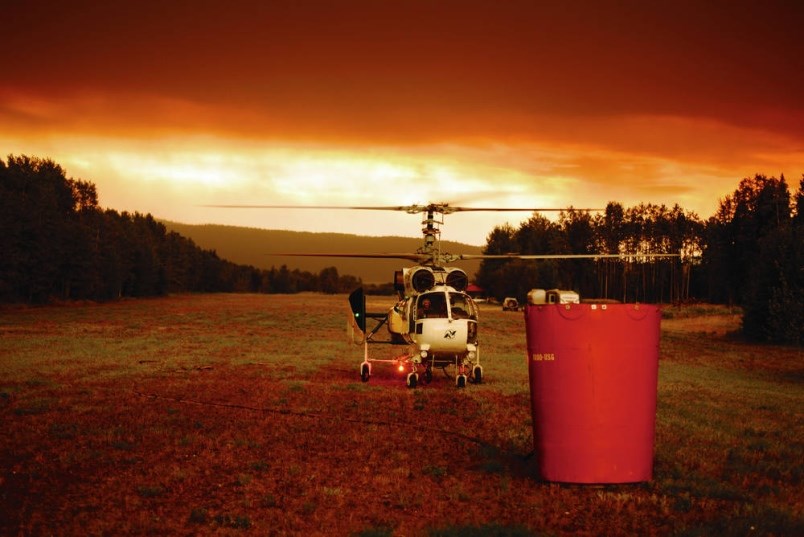As forests burn in British Columbia, Jen Norie is tracking a fleet of aircraft hitting the flames on the front lines.
The general manager of Vancouver Island Helicopters has pilots spread from Vanderhoof to Osoyoos. They’re in the Vernon and Kamloops areas and along the Coquihalla, dumping thousands of buckets of water on some of the largest wildfires in B.C., including the White Rock Lake fire, the highest priority in the province right now.
But attacking the flames involves more than just the pilots who pinpoint water strikes on spreading flames. Each of the company’s eight helicopters is supported by engineers, truck drivers and refuelling and mechanical crews.
It’s a total crew of 100 people in all, including safety managers, travel co-ordinators and administrative and support staff from VIH bases in Campbell River and Victoria International Airport.
Everyone is on high alert, ready to move at a moment’s notice.
It’s a finely tuned ballet of men, women and machines, a reputation earned over decades by Vancouver Island Helicopters’ deep roots in heli-logging, heavy lifting on construction sites and fighting wildfires.
Norie said this year is the first time that that the company’s aircraft fleet and support equipment has been contracted for continually renewing, one-to-two week contracts with B.C. Wildfire Service, providing four Kamov KA32s, two Bell 206s, a Bell 212 and a Bell 407 since late May.
In addition, VIH’s two Sikorsky S61s are providing fire suppression support in Alberta for the season.
“If we had more crews, we would have more aircraft in the [fight],” said Norie.
Norie said crews are busy and always challenged.
“The service vans and fuel trucks essentially follow the helicopters around and remain at the same location as the helicopters to provide maintenance and fuel, with crews working two weeks on, two weeks off,” she said.
The pilots fly eight hours a day, with maintenance engineers working early morning or late evening to keep the aircraft operating safely during daylight.
Norie said the B.C. Wildfire Service does a “great job with what they have to work with, and are very organized.”
Having more helicopters, crew and firefighters “would really help to truly get ahead of the wildfire situation. [But] with so many fires burning, there is only so much to go around,” she said.
The key for VIH to efficiently fight the fires, said Norie, is “cycle speed” — the turnaround time involved in filling buckets and hitting the fire.
Because ample water sources, such as lakes, are not always near a fire, the company has developed it own bucket technology, said Shane Palmer, director of operations at VIH.
“There are often beaver ponds and shallow streams close by,” he said.
So the company redesigned its 1,000-gallon buckets with a side pump (as opposed to bottom) that allows quick fills without clogging the intakes.
It can fill buckets at a rate of 2,200 gallons per minute in a body of water as little as two feet deep, so a full bucket can take about 20 seconds. The buckets are equipped to blend in fire-retardant gels at the same time.
“Cycle speed is a critical component in any firefight,” said Norie. “This allows us to draw from water sources in close proximity to the intended target, significantly reducing flight time while achieving more water drops in a much shorter amount of time.”
VIH is the only company in North America that uses the Russian-built Kamov KA-32, which has two top rotors spinning in opposite directions and no tail rotor. It’s a unique design and provides a powerful straight-up vertical lift — ideal for logging, construction and quickly hoisting heavy buckets of water.
“The KA32 helicopter is the most efficient helicopter available anywhere in terms of cents per litre of water put on a fire,” Norie said.
But the machines are only as good as the people at the controls, and Norie said VIH has some of the best pilots in the business.
“To be a safe and productive heli-logger for forestry clients, you have to be very precise and smooth,” said Norie. “These same qualities make our highly experienced pilots very adept at getting the water on target while fighting fires. It takes a lot of skill to consistently hit the target and maximize effectiveness without wasting 1,000 gallons of water.
“The expertise of our crews as well as the specialized nature of our aircraft and our operations means we can consistently deliver on time, on target and safely,” she said.
“I am extremely proud of the whole team and we all appreciate the opportunity to be able to contribute and help our neighbours and communities the best we can during wildfires.
“The courage, bravery and commitment of everyone involved in fighting wildfires is commendable, and we are very proud to be a part of those efforts.”





